SHARE
3 Catalysts used in Biomass Fuels: Agricultures meets Industry
Research on sources of alternative/renewable energies has increased in detriment of the traditional fossil fuels in the last few decades.
A very interesting trend is the biomass due to its limitless growth potential. Burning agricultural residues to generate clean energy has positive collateral effects, such as the release of organic matter that would have been released naturally through decomposition, which can generate twenty times more greenhouse-gas emissions. Besides, only in Brazil, the production of 14 billion liters of ethanol from sugar cane causes the creation of almost 2 million direct and indirect jobs.
 Furfural manufacturing plant
Furfural manufacturing plant
In conclusion, biofuels are a real alternative that can replace the use of non-renewable fossil fuels. However, in order to bet for this alternative, further research must be conducted on how to obtain them so that their development leads to more sustainable and integrated ways in industrial processes. Do you think biomass fuels can solve many engineering challenges? Is sustainability really that difficult to attain? Join our engineering community here
Agricultural Residues as a Source of Clean Energy
Biomass uses agricultural residues to generate fuels from renewable raw materials or to create chemicals that work as catalysts that help synthesize those biofuels. These catalysts are used for synthesizing biofuels and its function is crucial to make the transesterification reaction happen so that it is possible to quickly produce biofuel. Conventional catalysts are usually dissolved strong acids or strong bases, which makes it impossible for them to be recovered once the transesterification reaction has ended. Because of it, after the reaction, the catalysts must be neutralized and separated from the biofuel base at a high cost, which causes additional problems on the environment as well as the corrosion of the facilities. Besides, all these processes generate large amounts of residual water that also requires proper treatment.Catalysts used in Biomass Fuels
In order to improve that aspect of the biofuel production, conventional catalysts are being replaced for solid catalysts that allow its separation through filtration so that they can be reused later. However, their conversion rate is lower than for conventional catalysts. These are some examples of catalysts currently used in biomass fuels or catalysts under development: Carbonaceous solids: It has been recently reported the intense catalytic activity of carbonaceous solids that come from the incomplete charring of natural organic materials. In this sense, researchers of Whan University (China) have developed new catalysts based on carbonaceous solids formed from the shells of crustaceans. These researchers have charred partially the shells of the crustaceans, transforming the chitin, the shell's main component, into an open porous structure formed by functionalised polymers. After testing them in the lab, these new catalysts gave promising results on the biofuel production (90% conversion rate in 3h on the transesterification of canola oil+methanol at 65 ºC). Enzymatic catalysts: The enzymatic catalysis is thought to be a promising development for the biofuel production. The resulting products can be separated easily after using the catalysts, and enzymes require a lesser amount of alcohol to carry out the transesterification reaction. Nevertheless, despite the different results collected from multiple studies, the biofuel production on an industrial scale using enzymes has not been established due to two main factors: the high cost of biocatalysts and the long periods of reaction needed in some cases. Furfural: The chemical compound furfural is an industrial aldehyde that comes from agricultural sub products such as corn, oat or wheat. It is industrially obtained through dehydrating C5 sugars with liquid mineral acids and it has been identified as one of the chemical platforms that come from the biomass that have the most potential. Biorefineries based on furfural demand large amounts of investment and still present some technological risks. That is why research focuses now on obtaining those catalysts industrially, cost-efficiently and in an environmentally friendly way. Furfural manufacturing plant
Furfural manufacturing plantIn conclusion, biofuels are a real alternative that can replace the use of non-renewable fossil fuels. However, in order to bet for this alternative, further research must be conducted on how to obtain them so that their development leads to more sustainable and integrated ways in industrial processes. Do you think biomass fuels can solve many engineering challenges? Is sustainability really that difficult to attain? Join our engineering community here
